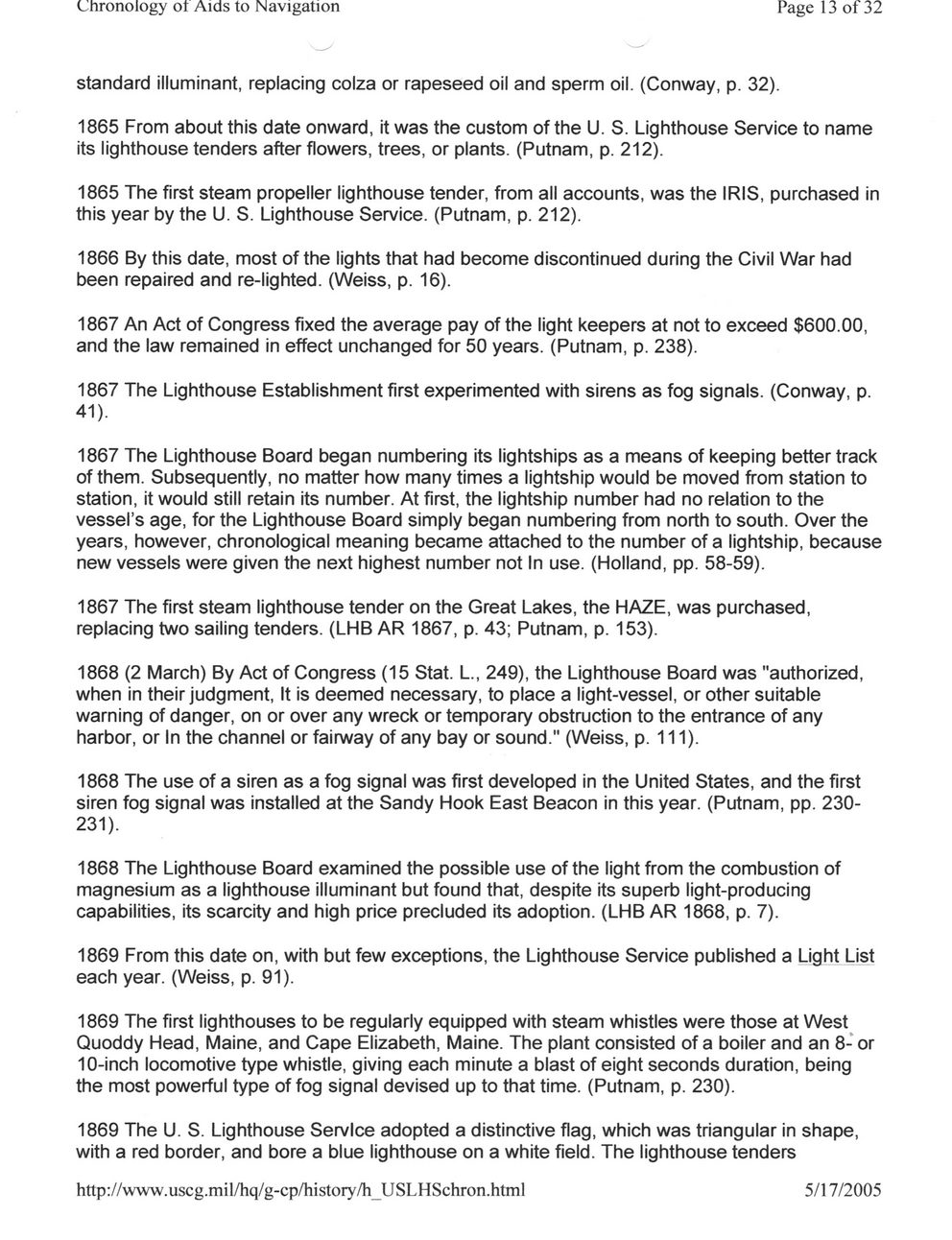This text was obtained via automated optical character recognition.
It has not been edited and may therefore contain several errors.
Chronology ot Aids to Navigation Page 13 of 32 standard illuminant, replacing colza or rapeseed oil and sperm oil. (Conway, p. 32). 1865 From about this date onward, it was the custom of the U. S. Lighthouse Service to name its lighthouse tenders after flowers, trees, or plants. (Putnam, p. 212). 1865 The first steam propeller lighthouse tender, from all accounts, was the IRIS, purchased in this year by the U. S. Lighthouse Service. (Putnam, p. 212). 1866 By this date, most of the lights that had become discontinued during the Civil War had been repaired and re-lighted. (Weiss, p. 16). 1867 An Act of Congress fixed the average pay of the light keepers at not to exceed $600.00, and the law remained in effect unchanged for 50 years. (Putnam, p. 238). 1867 The Lighthouse Establishment first experimented with sirens as fog signals. (Conway, p. 41). 1867 The Lighthouse Board began numbering its lightships as a means of keeping better track of them. Subsequently, no matter how many times a lightship would be moved from station to station, it would still retain its number. At first, the lightship number had no relation to the vessel’s age, for the Lighthouse Board simply began numbering from north to south. Over the years, however, chronological meaning became attached to the number of a lightship, because new vessels were given the next highest number not In use. (Holland, pp. 58-59). 1867 The first steam lighthouse tender on the Great Lakes, the HAZE, was purchased, replacing two sailing tenders. (LHB AR 1867, p. 43; Putnam, p. 153). 1868 (2 March) By Act of Congress (15 Stat. L., 249), the Lighthouse Board was "authorized, when in their judgment, It is deemed necessary, to place a light-vessel, or other suitable warning of danger, on or over any wreck or temporary obstruction to the entrance of any harbor, or In the channel or fairway of any bay or sound." (Weiss, p. 111). 1868 The use of a siren as a fog signal was first developed in the United States, and the first siren fog signal was installed at the Sandy Hook East Beacon in this year. (Putnam, pp. 230-231). 1868 The Lighthouse Board examined the possible use of the light from the combustion of magnesium as a lighthouse illuminant but found that, despite its superb light-producing capabilities, its scarcity and high price precluded its adoption. (LHB AR 1868, p. 7). 1869 From this date on, with but few exceptions, the Lighthouse Service published a Light List each year. (Weiss, p. 91). 1869 The first lighthouses to be regularly equipped with steam whistles were those at West Quoddy Head, Maine, and Cape Elizabeth, Maine. The plant consisted of a boiler and an 8- or 10-inch locomotive type whistle, giving each minute a blast of eight seconds duration, being the most powerful type of fog signal devised up to that time. (Putnam, p. 230). 1869 The U. S. Lighthouse Service adopted a distinctive flag, which was triangular in shape, with a red border, and bore a blue lighthouse on a white field. The lighthouse tenders http://www.uscg.mil/hq/g-cp/history/h_USLHSchron.html 5/17/2005

Lighthouses Chronology-of-Aids-to-Navigation-(13)